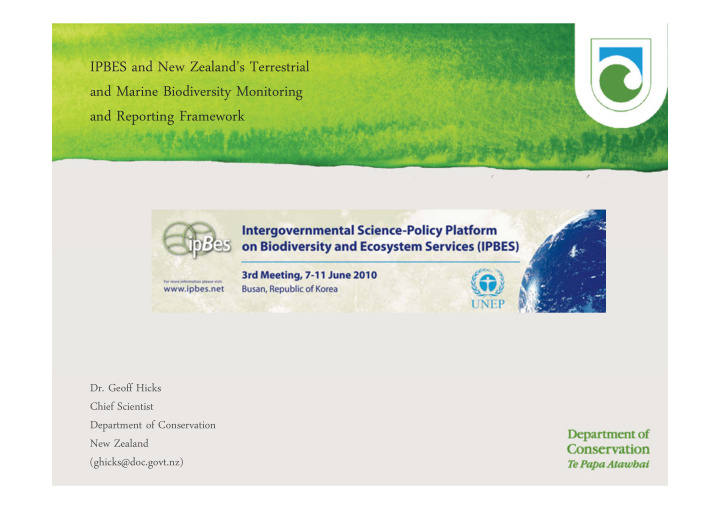



IPBES and New Zealand’s Terrestrial and Marine Biodiversity Monitoring and Reporting Framework Dr. Geoff Hicks Chief Scientist Department of Conservation New Zealand (ghicks@doc.govt.nz)
Convention on Biological Diversity Article 25: Subsidiary Body on Scientific, Technical and Technological Advice (SBSTTA) Functions: a) Provide scientific assessments of biodiversity status b) Assessments of outcomes c) Knowledge development and science/technical transfer d) Provide advice e) Respond to questions
Busan outcome “The new platform should perform regular and timely assessments of knowledge on biodiversity and ecosystem services and their interlinkages.”
Post-2010 Strategic Plan Target 19: “By 2010, [knowledge, the science base and technologies relating to biodiversity, its values and functioning, its status and trends, and the consequences of its loss are improved, widely shared, and applied.][Technologies related to biodiversity are widely transferred to developing countries on preferential terms.]”
New Zealand and IPBES 1. Review and assess each country's methodologies for determining status and trends at national scale 2. Negotiate and internationally agree a set of defensible and consistently applied indicators and measures for accurate, standardised and globally consistent assessment of status and trends 3. Mechanisms to transfer evidence base to policy 4. Small set of metrics must be simple, meaningful, inexpensive to apply and readily transferable
New Zealand’s Natural Heritage Management System (NHMS) What’s the problem? • Responsible for $6.1 billion (book value) of public conservation land • But we don’t know what’s happening to it (though we may think we do) • Spend $135 million every year on biodiversity mgmt • But we don’t know whether we’re doing the right things in the right places or what overall difference that work is making Growing pressure: national and international reporting obligations
New Zealand’s Natural Heritage Management System (NHMS) The Solution: National Monitoring and Reporting Scheme 1. National status and trends monitoring Answers the NHMS questions: • Measures overall status and trends in New Zealand’s What is the state and condition of natural heritage? biodiversity What are the trends in that condition? • Context for big decisions 2. Monitoring of managed species and places Answers the NHMS questions: • Monitors outcomes of active management What difference does our • Requires national consistency in project management make? monitoring How can we improve management?
Monitoring outcome Conserving natural heritage is maintaining ecological integrity: • Indigenous dominance (to maintain natural character) • Species occupancy (to avoid extinctions) • Ecosystem representation (to maintain ‘a full range’)
Measuring New Zealand’s ecosystem health What is an indicator? The Indicator Framework: a world first! • Sales trends for business • Blood pressure for health risks EI • Pest dominance for ecological Ecological ological health Integrity Integrity Freshwater Freshwater LEGEND Indicators Case studies EI Desktop Other agencies Marine Marine NHMS products (improved) Sampling Scheme
An integrated monitoring system Tier 3 Research Managed place Tier 2 monitoring Broadscale Tier 1 monitoring
Central curation of data Intranet now; Internet later
The National Sampling Scheme What is it? • Annual sampling programme • 1300 plots in 8 km grids over conservation land • Five-yearly measurement cycles • Others encouraged to do it too • Long-term commitment
8x8 km grid and LUCAS plot locations
How it looks: layout of sampling locations
Layout of a sampling location
Statistical analysis workshops Back Transformed Fitted Values with Original Data fitted(model7)^2 Call 2 4 6 8 10 12 Trounson Waipoua L/out Waitangi No 12 Kiwi call data 40 from Northland (annual) 30 20 10 0 Rangitane Rarewarewa Sand Bay Takahue Tiki-tikioure 40 Back Transformed Fitted Values 30 20 10 0 Paerata Puketi Puketi S R Puketotara Purua 40 30 20 10 0 Katui Marlow Road Marsden Cross Mimiwhangata Mt Bledisioe 40 30 20 10 0 Cathedral Diggers Vally Glenbervie 7A Glenbervie 9A Kaiaka 40 Measure 30 20 10 0 2 4 6 8 10 12 2 4 6 8 10 12 2 4 6 8 10 12 Time
Marine Classification and information layers examples National spatial layer for rocky reefs to 50m Inventory Catalogue and classify
NHMS Inventory & Monitoring Framework Marine examples National Outcome Targeted National Outcome Objectives Indicator (examples) Potential measure Potential elements Outcome (examples) (examples) Ecological Indigenous 1. Maintaining ecosystem processes Ecosystem disruption Disease outbreaks Where data is otherwise gathered by DOC: the area or proportion of protected species integrity dominance impacted or number of individuals affected. E.g. mass mortality events, occurrence of disease in marine mammals. 2. Reducing exotic spread and Naturalisation of new Occurrence of self-maintaining The number, abundance and distribution of dominance weed and pest species populations of potential selected adventive species that have environmental weeds and pests established themselves in New Zealand’s marine environment that pose a threat to managed marine sites. Data from MR monitoring and MAFBNZ. 3. Limiting environmental pollutants Ecosystem levels of Toxins in selected Persistent organic pollutants e.g. tissue persistent toxins environments and tissues of samples from marine mammals, sea birds. indigenous wildlife Data from RCs.
• GEO BON • Marine BON
Recommend
More recommend